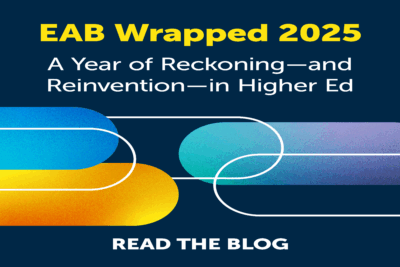Beyond the echo chamber
A few weeks ago, we gathered university leaders in Brisbane from across Australia and New Zealand to discuss the growing challenges of public trust in higher education and the loss of social license. Confidence surveys have dominated headlines, with each new release sparking debate about whether higher education is ‘winning’ or ‘losing’ public support and trust. And while the exact numbers fluctuate year to year, the scrutiny isn’t going away, and the loss of the public’s confidence has become a global HE issue. One key factor driving this crisis—and what shaped our roundtable conversation—is that institutional strategies too often stop short of addressing what the public actually needs from universities in both the priorities we emphasize and the language we use to describe our efforts.
The crux of the problem? Most universities still build institutional strategy from the inside-out, starting with internal stakeholder consensus and ending with familiar priorities. Academic excellence, research prestige, and student success are all worthy goals, but when plans stop there, external stakeholders—prospective students, parents, public officials, and donors—see little that speaks to their own needs and priorities.
If strategy remains purely inside-out, leaders can expect stalled enrolments, brittle funding, and flat employer demand. But if it moves to an outside-in perspective—inclusive of external priorities—institutions can align with stakeholder expectations, build broader support, and prove relevance in ways the public can see.
At our roundtable, we explored how to make that shift. Here are three moves leaders highlighted.
#1: Integrate next generation skill development into the curriculum
Graduates’ success increasingly depends on whether programs deliver skills employers can actually see and measure. Today, that means more fluency in new technologies, interpersonal abilities, and being able to collaborate with AI.
The predicted needs of Generative AI knowledge for future workers illustrate this clearly. Only about 5% of future knowledge-workers will need advanced technical expertise to build AI models. 25% will need to fine-tune AI tools and lead adoption in their organizations. However, the remaining 70%—the majority of our students—will need basic literacy to understand if and when to apply AI in daily work. And yet, most universities aren’t preparing that 95%.
A handful of institutions are showing what change looks like, though. For example, one university has an interdisciplinary honors course that pairs mixed-discipline student teams with employers to solve problems using GenAI. At another institution, internships are no longer optional; they’re built into graduation requirements, ensuring every student has real-world outputs to show employers.
These models point to a bigger shift: when skills are woven into the academic core experience, they stop being ‘extras’ and start being proof of value. The result? Employable graduates who can point to real projects and experiences that show the value of their degree, and employers who credit universities with preparing remarkable employees.
#2: Drive real-world impact by scaling community-centric research
While ‘blue sky’ or basic research is still critical at most institutions, community-centric research is gaining traction because it delivers visible wins for external stakeholders. The most innovative institutions are helping academics connect their research to real-world problems. At one institution, they pair academics with industry for short stint ‘externships’, helping academic staff reframe research agendas around applied needs. In fact, one university sends newly hired academics on a regional bus tour to connect them with local challenges, like transportation and education access, visibly aligning the university’s research agenda with community needs.
The payoff is clear. Community-centric projects are more attractive to funders, and they deliver outcomes that external stakeholders can see in action. That visibility builds trust at the local level, creating advocates for when universities need broader support.
It’s important to note that this shift isn’t frictionless—traditional promotion and training still reward older models of research. But small incentives and seed funds can lower barriers, making it easier for academics to try applied work and see its benefits firsthand.
#3: Catalyse mutually beneficial economic development
Universities already play a big role in their local economies through hiring, real estate, and workforce pipelines. What’s changing, though, is that they’re starting to organize that role more deliberately.
For example, a multi-anchor consortium (university + hospital + zoo) created a nonprofit development corporation to coordinate investment. This approach attracted funding for a 26-hectare innovation district, while also supporting small businesses. The results: thousands of jobs retained or created, millions of dollars in student wages from applied placements, and stronger advocacy from local leaders.
The lesson here is that when universities bring civic and industry partners together, they can deliver outcomes no single player could achieve on their own. And those visible contributions (new jobs, stronger pipelines, revitalized neighborhoods) translate directly into enrolment, partnerships, and public support.
What we learned and what comes next
Our roundtable conversations made one thing clear: defending higher education ‘as it has always been’ won’t rebuild public trust. The way forward is to treat outside-in alignment as a core strategy. In short, we don’t just need to tell our story better; as higher education, we need to invest in a better story to tell.
In our discussions, we used a simple filter to test ideas:
- Is this a real stakeholder need?
- Does it tie directly to institutional outcomes like enrolment, completions, or funding?
The three moves we discussed—integrating next-generation skills into the curriculum, expanding community-centric research, and anchoring local economic development—passed both tests. Each starts with external needs, but ends by strengthening the university itself. Good for us as universities, good for our communities.
At EAB, we help universities identify which outside-in investments will have the biggest impact. If you’d like to explore where your institution should focus first, get in touch with us by filling out the form below to connect with our team.
Implement Change With Confidence
To learn more about Strategic Advisory Services or speak with an expert, please fill out the form.

More Blogs

What our global partners asked us most in 2025

EAB Wrapped 2025: A year of reckoning—and reinvention—in higher ed
